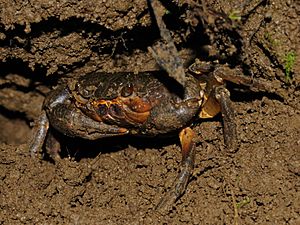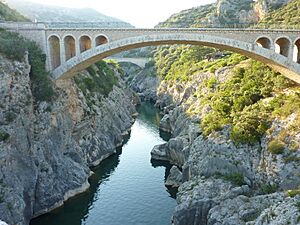Potamon ibericum facts for kids
Quick facts for kids Potamon ibericum |
|
|---|---|
 |
|
| Conservation status | |
| Scientific classification | |
| Genus: |
Potamon
|
| Species: |
ibericum
|
| Synonyms | |
|
Cancer ibericum Bieberstein, 1808 |
|
The Potamon ibericum is a type of freshwater crab found across Eurasia. This crab is an omnivore, meaning it eats both plants and animals. It often feeds on land, but it always returns to water. It can even survive short dry periods by hiding in burrows or under stones.
Its natural home stretches from north-eastern Greece, all around the Black Sea, and even past the Caspian Sea. Some of these crabs have also been brought to southern France by people. The Potamon ibericum is listed as a near threatened species on the IUCN Red List, which means it might be in danger in the future. It's also listed in the Red Data Book for Ukraine.
What Does It Look Like?
Potamon ibericum crabs are special because of a unique part of their body. Males have a specific organ called a first pleopod, which they use for reproduction. In P. ibericum, the flexible part of this organ is widest in the middle. This is different from other crabs in the same group, where this part might be V-shaped or have two lobes. This special shape helps scientists tell P. ibericum apart from its relatives.
Life and Habits

For Potamon ibericum crabs to survive, they usually need a place with permanent water. However, they are quite tough! They can live through short dry spells by hiding under stones or deep inside burrows. These burrows can sometimes be several kilometers away from the nearest water.
These crabs only reproduce in moving water. They mate during the warmer months, usually from June to October.
Potamon ibericum is an omnivore, which means it eats many different things. Their diet includes dead plant and animal matter (called detritus), stringy algae, and other plant parts. They also eat animals like worms, small crustaceans (like amphipods), young water insects, snails and clams, frogs and tadpoles, fish, and even dead animals (called carrion). They often feed on land at night. If the air is wet enough, they might even feed during the day. In areas where they live, these crabs are an important food source for the European otter.
Where Do They Live?
The natural home of P. ibericum is very wide, but it's also broken up into many separate areas. In Europe, you can find them in the Danube River and its smaller rivers in Bulgaria. They also live in rivers in North Macedonia, north-eastern Greece, Cyprus, and the European part of Turkey. You can also find them along the coast of the Black Sea, through Ukraine, and into the Caucasus region.
Even though its scientific name ibericum sounds like the Iberian Peninsula (Spain and Portugal), this crab does not live there naturally. The name actually refers to Caucasian Iberia, an ancient region in the Caucasus. In Asia, their range extends across Turkey to Iran and Turkmenistan.
Some places where P. ibericum used to live have become dry sometimes. This has caused the crab populations to shrink or even disappear completely. The northernmost areas where this crab can live are usually places where the average temperature in January is around 0 degrees Celsius (32 degrees Fahrenheit).
Potamon ibericum crabs were brought to the Cagne River in southern France between 1975 and 1983. This happened when people imported crayfish from Turkey for farming. Now, these crabs are found about 6 kilometers downstream from where they were first released. They live in a part of the river that rarely dries out. Another group of these crabs was found in the 1990s, about 300 kilometers away, in the Hérault River near Saint-Guilhem-le-Désert. Scientists don't think these introduced groups are causing harm to the local environment. Another type of Potamon crab, Potamon fluviatile, has also been introduced to France near Nice.
Conservation Status
Even though P. ibericum lives in many places, it is listed as near threatened on the IUCN Red List. This means that scientists believe it's possible that populations of P. ibericum could be in danger of disappearing in the future. This is especially true for those living on islands or near big cities. It might even become a vulnerable species soon. The species is also listed in the Red Data Book for Ukraine, which highlights species that need protection.



